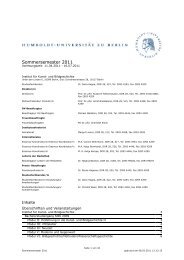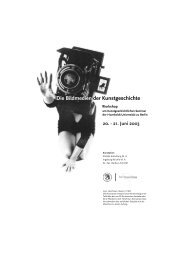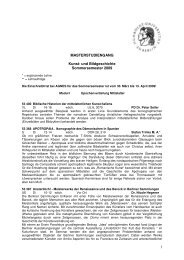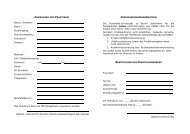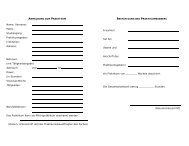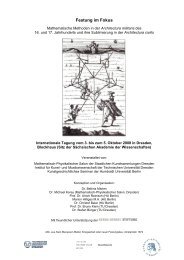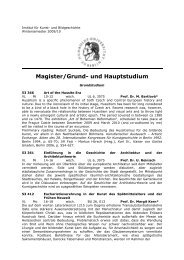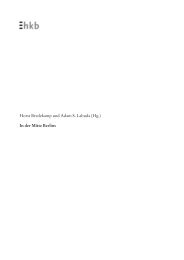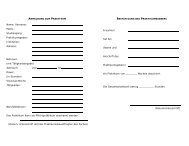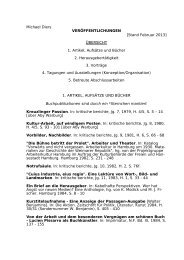Bauhaus Construct - Institut für Kunst
Bauhaus Construct - Institut für Kunst
Bauhaus Construct - Institut für Kunst
Create successful ePaper yourself
Turn your PDF publications into a flip-book with our unique Google optimized e-Paper software.
The Irreproducibility of the <strong>Bauhaus</strong> Object<br />
as a Brandt teapot, remains a work of art. To acknowledge this by con-<br />
ceding these objects’ elite, luxury status, however, calls into question the<br />
received, mythological account of the <strong>Bauhaus</strong>’s contribution to the trajectory<br />
of modernism. It also re-poses the question of what designing objects<br />
for mass reproduction—and socially transformative use by society, by the<br />
masses—might entail.<br />
Acknowledgments<br />
This essay has benefited from thoughtful suggestions by John Ackerman, Annie Bourneuf, Charles<br />
W. Haxthausen, Jennifer Hock, and Klaus Weber, whom I would like to thank. I also thank Peter<br />
Nisbet and Laura Muir at the Busch-Reisinger Museum, Harvard University, and Sabine Hartmann<br />
at the <strong>Bauhaus</strong>-Archiv, Berlin.<br />
Notes<br />
1 For related discussion of these concerns, see especially Frederic J. Schwartz, “Utopia for<br />
Sale: The <strong>Bauhaus</strong> and Weimar Germany’s Consumer Culture,” in <strong>Bauhaus</strong> Culture: From<br />
Weimar to the Cold War, ed. Kathleen James-Chakraborty (Minneapolis: University of Minnesota<br />
Press, 2006), 115–38; and Anna Rowland, “Business Management at the Weimar<br />
<strong>Bauhaus</strong>,” Journal of Design History 1, no. 3–4 (1988), 153–75.<br />
2 Walter Benjamin, “The Work of Art in the Age of Its Technological Reproducibility,” in Walter<br />
Benjamin: Selected Writings, ed. Howard Eiland and Michael W. Jennings, vol. 3, 1935–1938<br />
(Cambridge, MA: Harvard University Press, Belknap Press, 2002), 101–36. Benjamin composed<br />
this essay in the autumn of 1935; the version used here is the 1936 second version<br />
which the editors note represents the form in which Benjamin originally wished to see the<br />
work published. A third, revised version remained unfinished at Benjamin’s death and was<br />
published posthumously. See also Benjamin, The Work of Art in the Age of Its Technological<br />
Reproducibility, and Other Writings on Media, ed. Michael W. Jennings, Brigid Doherty, and<br />
Thomas Y. Levin (Cambridge, MA: Harvard University Press, Belknap Press, 2008).<br />
When Benjamin makes his famous proclamation, “What withers in the age of the technological<br />
reproducibility of the work of art is the latter’s aura,” he immediately follows it<br />
with: “This process is symptomatic; its significance extends far beyond the realm of art”<br />
(emphasis added, 104). He begins his essay, in a similar vein, with Marx, noting that it<br />
“has taken more than half a century for the change in the conditions of production to be<br />
manifested in all areas of culture” (emphasis added, 101). In the essay, Benjamin largely discusses<br />
this process as it manifests itself in images and film. However it is clear throughout<br />
that the significance of the phenomena he explicates is not limited to these areas of culture<br />
alone; Benjamin also specifically addresses architecture, literature, medicine, music, and<br />
coins. Moreover, Benjamin uses a number of different terms to refer to his subject, not only<br />
“artwork” (<strong>Kunst</strong>werk), but also object of art (Gegenstand der <strong>Kunst</strong>), object (Objekt), thing<br />
(Sache), all of which have been predominantly translated as “artwork,” perhaps contributing<br />
to a common perception that Benjamin is only talking about the visual arts.<br />
The distinct importance of architecture at a late stage in Benjamin’s discussion—which<br />
brings it into particular proximity with film and makes “the laws of its reception … the most<br />
instructive” in relation to new forms of mass participation in art—lies in the fact that buildings<br />
are received in a twofold manner: by perception and by use (120). The significance of<br />
55



